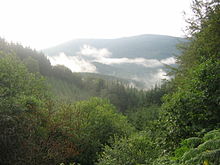Morvan
The Morvan is a granite massif in the Burgundy ( Bourgogne ) region in eastern France . It extends over the departments of Yonne , Saône-et-Loire , Nièvre and Côte-d'Or .

Natural space
Geologically, the Morvan region belongs to the Massif Central and is also known as La montagne noire ("Black Mountains") (not to be confused with the Montagne Noire in southern France). This name comes from the dense mixed forests and the large heather areas , which are mainly characterized by fern and gorse .
The Morvan Regional Nature Park has been protecting the sparsely populated region, rich in rare flora and fauna, since 1970 . Red deer , European mouflon , pheasant , partridge , capercaillie , badger , fox , wildcat , buzzard and hawk populate the forests and heather areas of the low mountain range.
The highest elevation of the Morvan and thus also of Burgundy is the 901 m high Mont Haut-Folin .
Many rivers in the region have their source in the Morvan, such as the Yonne , Arroux and Cousin . Therefore, the Morvan is also an important drinking water reservoir . This is indicated by several mineral springs , such as in Saint-Honoré-les-Bains , and some reservoirs , such as the Lac de Saint-Agnan , the Lac des Settons and the Barrage de Pannesière-Chaumard . Both reservoirs were originally created to regulate the water in the Burgundian shipping canals . The two most important canals in the Morvan area are the Canal de Bourgogne and the Canal du Nivernais .
History and settlement
The Morvan has always been a sparsely populated region and characterized by poverty. The population lived from meager agriculture and the men worked as loggers and raftsmen on the numerous rivers in the region. The women earned their living as wet nurses to whom the public welfare organization entrusted Les petits Paris , orphans from Paris . In the Middle Ages , it was the Cistercians who built numerous clauses and chapels in the region, cleared the barren soil and made a major contribution to the region's development. Even later, monks settled in the Morvan: the Abbaye De La Pierre-Qui-Vire abbey was founded in 1850 and is still in use today.
During the German occupation of the country in World War II , the region was a focus of the Resistance , with up to 10,000 fighters at its peak in the summer of 1944, shortly before liberation. The current government honors this by including Morvan in the register of Chemins de mémoires, the “Street of Memorials”.
Cultural monuments
The international excavations of Oppidum Bibracte on Mont Beuvray (800 m) near Saint-Léger-sous-Beuvray are important for the development of Celtic history . In a structurally and didactically appealing museum created in the late 1990s, Celtic exhibits and the latest results of the excavation process are presented. The archaeological excavations and the development of Oppidum Bibracte, which would have been difficult to do without the support of Mitterrand (who was mayor of Château-Chinon ), can be actively followed on Mont Beuvray. The center of archaeologists is the village of Glux-en-Glenne . Internships are possible for archeology students and youth groups. The city of Autun (the former Augustodunum ) as the Roman counterpart to Bibracte, sister city of Ingelheim in Rheinhessen, is a regional center with a corresponding infrastructure.
Places in and around the Morvan
- Autun
- Avallon
- Château-Chinon
- Corbigny
- Dun-les-Places
- Quarré-les-Tombes
- Saint-Brisson
- Saint-Léger-Vauban
- Saulieu
- Vezelay
Web links
- Official website of the Morvan Natural Park (French)
- Morvan with Lormes.net (French, English, Dutch)
- Musée de la Résistance en Morvan , Chemins de Mémoire (German)
- Resistance , the "Maquis Bernard" at Ouroux-en-Morvan (in French)
notes
- ↑ → Sitemap: Village d'art → below: Sites historiques → Plus d'info sur le maquis OR → L'homme d'ombre (work of art in memory of the fighters)


